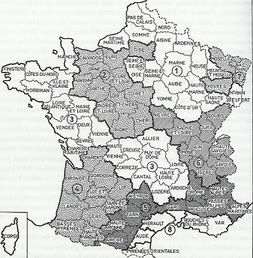|
|
Post by Liquid Len on Dec 28, 2005 16:18:31 GMT -5
It's from a rather recent study and using relatively fresh statistical data (i.e. not from Deniker's age  ):  Short descriptions of the average type of each zone, followed by my interpretational proposal: 1: tall, mesocephalic, hair brunet, eyes light-mixed: pred. Nordic 2: shorter, mesocephalic, hair brunet, eyes light-mixed: intermediate between 1 and 3 3: shorter, brachycephalic, hair brunet, eyes light-mixed: pred. Alpine 4: shorter, slightly brachycephalic, hair brunet, eyes brown: mixed, but still pred. Alpine 5: tall, mesocephalic, hair brunet, eyes brown: pred. Atlanto-Mediterranean 6: tall, brachycephalic, hair brunet, eyes light mixed; in some areas heavy built, in others slender: Noric influenced and/or with tall Alpinoids/Borreboids 7: tall, slightly brachycephalic, hair brunet, eyes light mixed; heavier built than 1: like 6, but more Nordic 8: shorter, mesocephalic, hair brunet, eyes brown: either a more gracile Med influence or recent admixture from Alpine areas (more likely imho) |
|
|
|
Post by wendland on Dec 29, 2005 2:11:24 GMT -5
What's the difference between a brunet Nordic and an Atlanto-Mediterranean? In fact, the only difference between zone 1 and zone 7 is that zone 7 has brown eyes. So the eye color makes the difference?
It's interesting to see that there is no special type for Normandy, as some overstate the importance of Northmen settling there, yet they never amounted to more than 2% of the population, and were, at least culturally, absorbed in 2 generations.
|
|
|
|
Post by galton on Dec 29, 2005 3:31:54 GMT -5
They're all caucasians, right?
|
|
|
|
Post by Liquid Len on Dec 29, 2005 5:25:30 GMT -5
What's the difference between a brunet Nordic and an Atlanto-Mediterranean? In fact, the only difference between zone 1 and zone 7 is that zone 7 has brown eyes. So the eye color makes the difference? Apparently, yes. But it is known that genes for darker colours are dominant over those for the lighter ones, so If those in the North don't have that dark eyes, they must have more of a Nordid component than of a Mediterranean one. And furthermore, to me it's clear that a type without dark eyes can't be called Mediterranean. It's also noteworthy that Coon's "Keltic Nordic" was a little stronger pigmented than the more classical Hallstatt type. And even according to the more classical descriptions, at least light brown hair is still considered as being in the normal range of Nordid variation. Admitting only blond hair is a simplification, and in that case even the Swedes wouldn't be that Nordid. They're all caucasians, right? Of course; even if there are slight other admixtures, it's about the average types, and these will be Caucasoid. And I suppose they only considered the more or less indigenous Frenchmen for this study, in any case not the foreigners. |
|
|
|
Post by wendland on Dec 29, 2005 20:34:28 GMT -5
As far as I know, at least in the case of haploytype and genotype studies, they only take rural populations as these are more representative of a place, being much less transient.
|
|
|
|
Post by Liquid Len on Jan 1, 2006 15:14:49 GMT -5
A bigger version:  |
|
kibou
New Member

Posts: 15
|
Post by kibou on Jan 5, 2006 12:25:16 GMT -5
Using departements has no meaning.
|
|
|
|
Post by Liquid Len on Jan 31, 2006 19:59:01 GMT -5
What I forgot to mention: There were no modern statistics of the cephalic index available for zone 5 and 8 when the study was made... So what I wrote about them is a little hypothetic. However, it's clear that zone 8 was already meso- to dolichocephalic around 1900, so it's unlikely that it's now in the brachy area. And zone 5 was quite heterogenous and varying, from low to medium brachycephalic. If we suppose that the CI there has fallen about by the same magnitude as on the northern edges of the Massif Central region - then we can assume a mesocephalic index nowadays. (Unfortunately this change of CI wasn't everywhere the same; in fact there are even some departements in the West where the CI has risen from high meso- to low brachycephalic, probably due to mixture.)
|
|